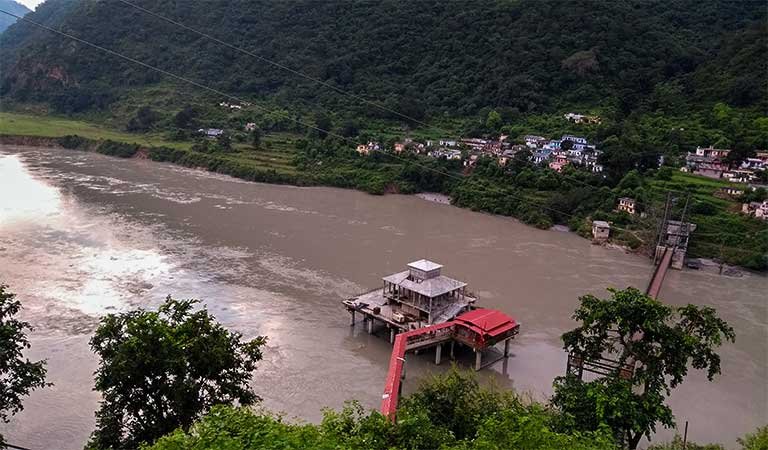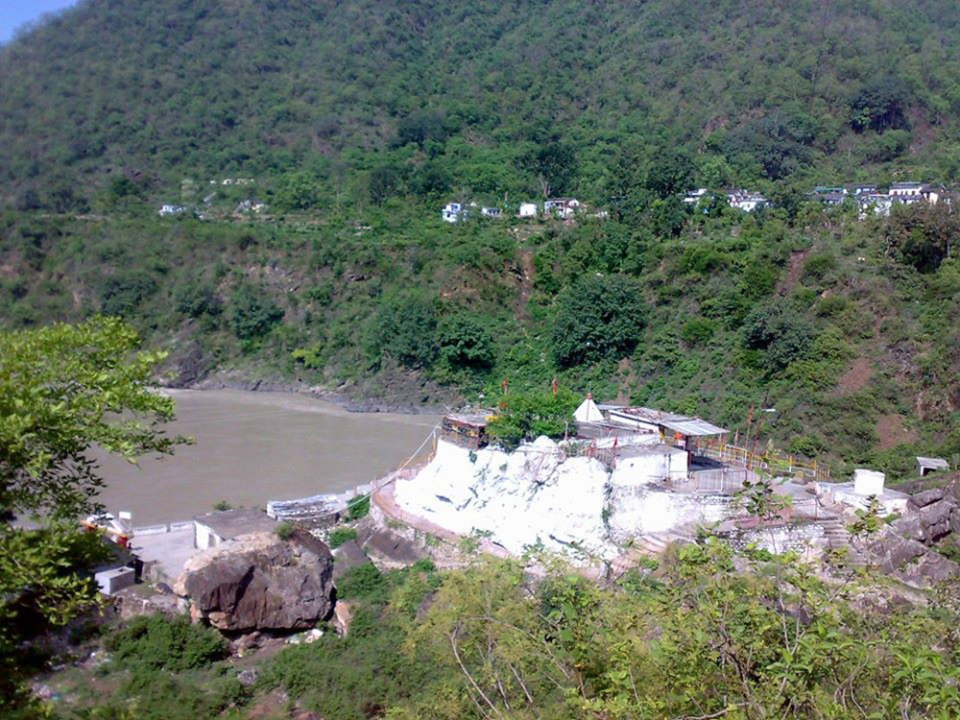The Dhari Devi temple, dedicated to Goddess Kali, holds great religious significance in the Himalayan state of Uttarakhand, India. Nestled on the banks of the Alaknanda River between Srinagar and Rudraprayag in Garhwal region, this modest temple is revered as the guardian of Uttarakhand and its sacred Char Dham pilgrimage circuit.

Maa Kali here sits in open air, worshipped by devotees as the fierce and powerful Hindu goddess who protects the land and its people. Locals strongly believe that the region’s wellbeing lies in the goddess’ hands, with legends of her strength and miracles stirring intense devotion. Let’s delve into her history, myths, temple architecture, festivals, and more in this guide to the protector deity Dhari Devi.

The Old Dhari Devi Temple nestled amidst Himalayan peaks
History and Mythology
The genesis of the Dhari Devi temple ties into intriguing myths pointing to the goddess’ divine nature and supernatural origins.
Mythological Origins
Local legend says the original idol of Goddess Kali was found trapped against a rock amidst the swirling currents of the Alaknanda river during a great flood. Divine instructions were then heard to place the idol upon that very spot and build a shrine there.
Villagers installed the reddish-black stone statue weighing over a ton at its present location on the riverbank. A temple was built, but without any roof, as covering would displease the goddess. The idol thus sits under open skies, drawing devotees from across India with its raw, primal spiritual power.
The Two Goddess Forms
An intriguing mythological aspect of Dhari Devi is her connection to the Kalimath temple further downstream, near Guptkashi village. Here the local goddess is also worshipped as Kali, but only the lower half of the figure.
In contrast, Dhari Devi enshrines only the upper torso till the midriff, with the navel clearly visible. Worshippers thus revere the two sites as representing the separated halves of Kali. Together, they form the whole of the fierce mother goddess devotees across India turn to for courage and protection.
A Revered Shakti Peeth
The Dhari Devi temple finds mention as one of the 108 Shakti Peethas – highly sacred pilgrimage destinations for Hindus centered around various local goddesses representing forms of Devi or cosmic feminine energy.
These temples symbolize sites where mythology states parts of the goddess Sati’s body fell when Lord Shiva carried her corpse after she self-immolated. Specific body parts of Sati are enshrined across these 108 holy shrines. At Dhari Devi, the upper torso or breasts are believed to have fallen, making it a key Shakti Sthal for devotees of the Divine Mother.
A Shape-Shifting Idol
According to regular devotees and temple caretakers, the idol of Dhari Devi mysteriously alters its physical form during the day. In the morning she appears like a young girl child, by afternoon she transforms into a radiant young woman, while at night she becomes an elderly woman with gray hair. Priests ritually adorn the goddess in keeping with these changing manifestations.
Some consider this a divine miracle hinting at Kali’s cosmic nature, while skeptics dismiss it as smart tricks of lighting combined with vivid imaginations of highly devoted pilgrims!
Guardian of the Char Dham
The Char Dham pilgrimage holds great religious significance as an auspicious circuit of four abodes of the gods – Badrinath, Dwarka, Puri and Rameswaram. For locals, Dhari Devi is intrinsically tied to the security of the entire route and ensures safe pilgrimage for all Hindu devotees undertaking this grand journey. Her protection and blessings are seen as vital by both pilgrims and temple caretakers along the holy circuit.
With her raw spiritual potency and intriguing mythology, Dhari Devi captures imagination while also feeling reassuring as a protective shelter for all.
The Dhari Devi Temple
The heart of the shrine lies in its rustic temple by the riverside, with intriguing history including supernatural events in recent times.
The Original Temple Site
The existing Dhari Devi temple was built fairly recently in 2017, at the very same spot on the Alaknanda riverside where the original ancient shrine once stood for centuries.
In 2013 on June 16 , the old temple was unfortunately removed from its root (mool sthan) due to construction of resrvoir of Alakananda hydro electric project.
On same day 16 June hours after the idol was uprooted from its old place and moved, a massive cloudburst hit the Kedarnath valley, which washed away the entire shrine town of Kedarnath and killing hundreds of people. Locals believe the unprecedented scale of floods and destruction was the wrath of Dhari Devi, angered after the government relocated her temple to make way for a major hydroelectric project dam construction nearby.
Over 110 villagers perished in the area, while the temple and everything around was completely destroyed in a matter of days. The Goddess’ idol however miraculously survived the flood’s devastation, found calmly lying amidst the debris.
Restoring the Goddess Home
Given intense protests by locals and Hindu groups like VHP, the contentious dam project was scrapped, and Dhari Devi’s shrine rebuilt once more at its original sacred spot on the Alaknanda’s banks, where she resides happily once again.
Regular poojas, arti and rituals resumed with gusto, while the influx of devotees only increased after publicity over the temple’s supernatural connection with the disastrous floods as an angry Goddess’ reaction to relocation. For locals, media coverage further vindicated long-held traditional beliefs in Dhari Devi’s divine nature and protective stewardship over the region.


Construction of new Mandir Site
Temple Architecture
In keeping with the Goddess’ mythological preference for open skies above her head symbolizing freedom, the newly rebuilt Dhari Devi temple enshrines the revered idol under a simple tin roof providing shade while still allowing open air.
The single-room shrine features walls painted yellow, with a small framed interior featuring the smoothed black stone Goddess figure draped in colorful silks and loaded with flower garlands. She seems to virtually leap out amidst a scintillating red backdrop. The frame’s bottom stores smaller figures of Lord Ganesha and Goddess’s lion vehicle.
The temple entrance, marked by red curtains, directly faces the gushing grey-green waters of the Alaknanda – merging point for two Hindu pilgrimage triangle circuits. Temple surroundings offer a serene ambience despite crowds – surrounded by verdant deodar forests and mighty Himalayan peaks on all sides, with river’s soothing, eternal murmurs.
Daily Rituals and Celebrations
The Dhari Devi temple hosts elaborate daily puja rituals with arti offerings by hereditary Brahmin priests at dawn, noon, dusk and midnight. Special seasonal pujas also occur during Navaratri celebrations.
The most spectacular temple festival is the 3-day annual Mela coinciding with Diwali, featuring over 50,000 pilgrims. Locals indulge in cultural programs while camping on the riverbanks and surrounding hills. The Goddess receives ornate flower, silk and jewelry offerings along with Vedic chants and celebratory folk dances like Jhumeila with much fervor and gaiety.
Nearby Attractions and Excursions
While Dhari Devi draws priority as the prime pilgrimage hotspot, several picturesque locales around also warrant exploring for history buffs, nature lovers and wandering souls.
Khirsu Village
Just 6 kms uphill from the main temple sits the pristine Khirsu village surrounded by fruit orchards and panoramic Himalayan views. British established an off-season colonial retreat here in early 1900s, with their wooden homes still intact amidst scenic pine forests. It serves as a lovely day-hike with charming vintage architecture now converted to cozy homestays for tourists.
Ancient Temples Amidst Forests
The dense hill forests around Dhari Devi hide several intriguing ancient temples enveloped in rich mythology. Kand
Ancient Temples Amidst Forests
The dense hill forests around Dhari Devi hide several intriguing ancient temples enveloped in rich mythology. The secluded Kandoliya temple lies ensconced within verdant pine groves just 4kms uphill. This modest stone shrine dedicated to Lord Shiva is believed to be over 1200 years old!
Further up at Karanprayag town lies the magnificent rock-cave Kyunkaleshwar temple bordering the Mandakini river. Dedicated to Lord Shiva, its origins trace back to the 8th century, built by ruler King Mankades. It is considered among the Panch Kedar shrines, and offers sweeping Himalayan mountain views.
Confluence Point of Pilgrimage Routes
The prime attraction just 1 km downstream from Dhari Devi is sacred Rudraprayag – the hallowed point where Alaknanda and Mandakini rivers meet.
Regarded among the Panch Prayags of central Himalayas, Rudraprayag offers blissful views of the river confluence with temples dotting its banks, surrounded by gorgeous mountain scenery. The rivers merging here form the route ahead towards Badrinath shrine of Char Dham circuit.
Travel Information
Visiting Dhari Devi requires some planning and preparation regarding the best time, logistics and local terrain.
Best Time to Visit
Peak pilgrimage season is during October and November, coinciding with warmer weather and Diwali-Kartik Navratri celebrations when the Dhari Devi Mela occurs. Summers are blazing while winters intensely cold.
April-June and September-November remain ideal with pleasant weather. Carry some warm clothing nevertheless given chilly winds.
Reaching Dhari Devi
The nearest major transport hub is Dehradun Jolly Grant airport. Flights operate daily from Delhi and other metro cities. Taxis/buses directly connect Dehradun and Dhari Devi temple (140km, around 5 hours).
Haridwar railway station is the closest railhead just 90 km away, with all trains connecting major Indian cities stopping here. State transport/private buses frequently cover Haridwar-Dhari Devi route (4 hours).
Rishikesh also has good road/rail links being just 130 km from the temple. Shared jeeps connect Rishikesh with Srinagar (1.5 hours), just 14 km before Dhari Devi.
Local Stay Options
Pilgrim lodges exist right by Dhari Devi riverside, while Srinagar town offers modest hotels. Upscale hotels come at Rudraprayag or Karanprayag. Camping facilities are also available, like Vedic Himalaya Village’s riverside luxury tents.
Homestays around Khirsu village provide a peaceful village living experience amidst splendid nature. Limited accommodation is available at Kandoliya temple guesthouse by directly reaching out to temple authorities.
Practical Travel Tips
When undertaking the spiritual journey to Dhari Devi temple, keep these handy pointers in mind:
Clothing – Modest attire like salwar-kameez or saree for women, avoiding short dresses or skirts. Carry shawls and jackets.
Bags – Backpacks better than trolleys given the hilly terrain around temple.
Photography – Permitted only outside temple premises. Maintain decorum inside shrine.
Precautions – Carry own drinking water, emergency medical supplies given remote location. Remain alert about local alerts on weather or surrounding forests. Carefully plan day trips to nearby ancient temples in remote locations by understanding terrain and route maps, carrying food/water and avoiding solo trips. Check for latest updates on temple timings, celebrations or disruptions before visiting.
With her blessings, the journey promises spiritual awakening and joyous memories in Uttarakhand’s lap!


